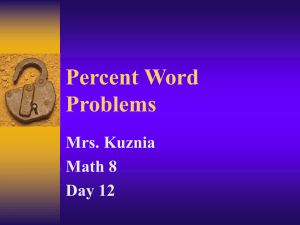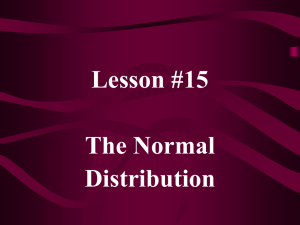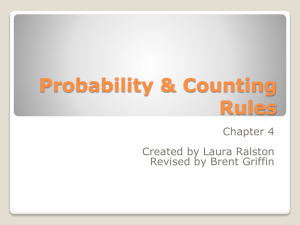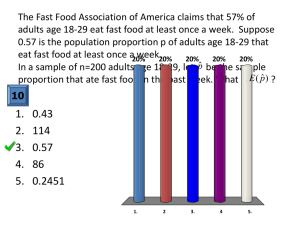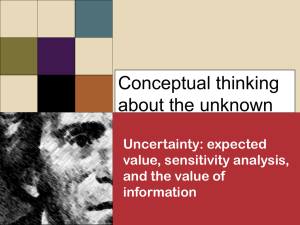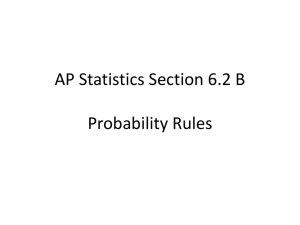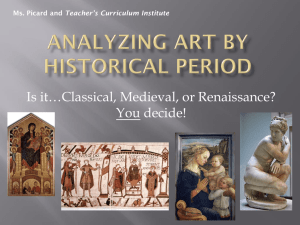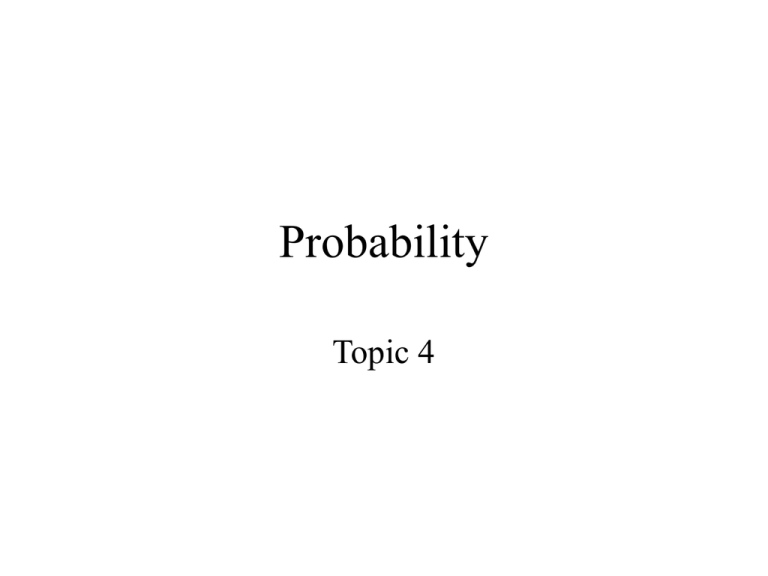
Probability
Topic 4
Probability
• Until now we’ve discussed descriptive statistics
– Methods for organizing and summarizing data
– Graphical and numerical displays
– Linear regressions
• Collection and production of data
–
–
–
–
Sample design
Observational studies
Design of Experiments
Simulation
Probability
• We will now study a few more topics that
will set the stage for our study of inferential
statistics
• We’ve mentioned already that inferential
statistics involves making conclusions about
a population based on information/data
collected from a sample from that
population
Probability
• Because we are drawing conclusions about the
population based on a sample, we can never be
certain that our conclusions are 100% correct.
• That is, there is some uncertainty.
• Probability is the study of uncertainty and
provides some of the foundation for our study of
inferential statistics – confidence intervals and
hypothesis testing.
Spinning Wheel Activity
• This experiment consists of spinning the
spinner 3 times and recording the numbers
as they occur. We want to determine the
proportion of times that at least one digit
occurs in the correct position. For example,
in the number 123, all of the digits are in
their proper positions, but in the number
331, none are.
Guess, Experiment, Theory
• First, let’s guess the proportion of times at
least one digit will occur in the proper
position.
• How would you simulate this if you didn’t
have a spinner?
• Let’s do the activity.
• Later we’ll calculate the theoretical
probability.
Probability
•
•
•
•
•
Chance exists all around us.
Human design – casinos
In nature – sex of a child
Probability is the study of chance or uncertainty.
Chance behavior – like our activity – that seems
haphazard and unpredictable in the short run, has a
regular and predictable pattern the the long run.
Let’s do another activity
• Flipping a coin
• Let’s flip it 100 times and record/graph the
proportion of heads.
• In the short run, this proportion or
probability is unpredictable.
• In the long run, the proportion of heads
approaches the probability of getting ahead
-- .5.
Random vs Haphazard
• Random is not synonymous with haphazard.
• Random is a description of a kind of order that
emerges in the long run.
– Uncertain but a regular pattern in the long run
• We often encounter the unpredictable side of
randomness in everyday life, but we rarely see
enough repetitions of the same phenomenon to
observe the long run regularity that probability
describes.
• Probability is the proportion of times an outcome
occurs in the long run – long term relative
frequency.
• Probability theory is the study of uncertainty, the
study of random behavior.
Terminology
• Chance experiment: an activity or situation where
there is uncertainty about what outcome out of
many possible outcomes will occur.
– Our spinning wheel activity
– Equal Likelihood model
• Sample space: the collection of all possible
outcomes of a chance experiment
– {123} {121} {122} {111} …
– Tree diagram
More Terminology
• Event: collection of outcomes from the
sample space of a chance experiment
– A: second digit is correct
• Simple event: an event that is made up of
exactly one outcome
– B: all digits are correct
Notation and Displaying Events
• Notation: E = event all digits in correct place
• Venn Diagrams
E
not E
Relationship Among Events
• Complement
– AC
– The event A does not occur
– Venn Diagram
• Intersection
– A B ‘A and B’
– The event A and B occur
– Venn Diagram
• Union
– A B ‘A or B’
– The event either A or B occurs
Examples
• Playing Cards
–
–
–
–
–
A = card selected is a kings of hearts
B = card selected is a king
C = card selected is a heart
D = card selected is a face card
a. (not D) b. (B and C) c. (B or C)
• Describe the events
More about relationships
• Mutually exclusive or disjoint events: two or
more events are said to be mutually exclusive if at
most one of them can occur when the experiment
is performed, that is, if no two events have
outcomes in common
• E = card selected is black
• F = card selected is a diamond
• D = card selected is a face card
• Relationship between E and F, E and D, F and D?
Approaches to Probability
• Probability is the study of uncertainty – the
mathematical characterization of uncertainty
• Notation: P(A) =
• Interpretation of Probability:
– Near 0 – unlikely
– Near 1 – very likely
– Frequentist interpretation – proportion of times an event
will occur in a large repetition of trial of the experiment
• The Classical Approach
• The Relative Frequency Approach (Empirical
Approach)
• The Subjective Approach
Subjective Approach
• We’ve already seen this approach during the
sinning wheel activity when I asked you what you
thought the proportion for digits in correct places
would be
• We use the subjective approach to quantify
likelihood of events all the time
– Should I wear a rain coat
– Should I speed
– Should I do my homework
Empirical Approach
• Also called the relative frequency approach
• Using an experiment or a simulation allows us to
determine probabilities using the empirical
approach
•
num berof tim es E occurs
P E
total num berof trials
• As the number of repetitions of a chance
experiment increases, the chance that the relative
frequency of occurrence for an event will differ
from the true probability of that event by more
than a small amount approaches 0
Law of Large Numbers
• As our number of trials grows larger and
larger, the relative frequency of our event
approaches the true probability of that
event.
Examples of the Empirical
Approach
• Spinner Activity
• Flipping the coin
• For equally likely outcomes, you can arrive
at the correct probability using either
approach
• Not so with outcomes that are not equally
likely
Classical Approach
• First, some notation – probability of an event
• Classical Approach says
num berof outcom es favorableto E
P E
num berof outcom esin the sam ple space
• To use the classical approach to determine
probabilities, all outcomes must be equally likely
– games of chance
• Go back to our spinner activity to calculate the
probability
Limitation to the Classical
Approach
• Consider accident rates of young adults driving
cars. Who do you think has a higher insurance
rate, an 18 year old or a 35 year old? Why?
• Using the classical approach when you consider
an insurance policy for an 18 and 35 year old,
there are 2 outcomes –having an accident and not
having an accident – and those outcomes are
equally likely for the 18 and 35 yo. The
probabilities that each would have an accident
using the classical approach is .5. Which defies
reason and experience.
Basic Properties of Probability
• For any event E, 0 P( E ) 1
• If S is the sample space for an experiment,
then P( S ) 1
• If two events E and F are mutually
exclusive, then P( E or F ) P( E ) P( F )
– General Addition Rule: P( AorB) P( A) P(B) P( A & B)
• For any event E, P( E) P( E ) 1
C
Conditional Probability
• Sometimes the knowledge that an event occurred
changes the likelihood that another event will
occur
• A simple example. Let’s say we have 2 events
–
–
–
–
A: You choose a face card
B: You choose a King
Without any other info, what is P(B)?
What is the probability of choosing a King given you have chosen a
face card?
• Let’s say 1% of the population has a certain disease. You can’t tell if
you have the disease unless you are tested. Let’s say that 80% of the
people who test positive have the disease – 20% who test positive
don’t have the disease.
–
–
–
–
E: You have the disease
F: You test positive
Without any info, what is P(E)?
Let’s say you test positive, what is P(E)? In other words, what is the
probability you have the disease given you test positive?
Notation for Conditional
Probability
•
P( E \ F )
• Read as “the probability of event E given F
has occurred”
An example using two-way tables
• The ASU Statistical Summary provides information on
various characteristics of the ASU faculty. Data on age
and rank of ASU faculty is presented in the table below.
Full
Prof
Assoc
Prof
Asst
Prof
Inst
Total
<30
2
3
57
6
68
30-39
52
170
163
17
402
40-49
156
125
61
6
348
50-59
145
68
36
4
253
>60
75
15
3
0
93
Total
430
381
320
33
1164
Determine some probabilities
•
•
•
•
•
Let’s select faculty at random
P(Asst Prof)
P(30-39)
P(Full Prof \ 40-49)
P(50-59 \ Asst Prof)
Definition
P( E F )
• P(E \ F) =
P( F )
• Let’s use this definition to determine
– P(Instr \ 30-39)
– P(40-49 \ Asst Prof)
A Summary
•
•
•
•
•
•
Probability – the study of uncertainty
Chance experiment
Event/Simple event/Sample space
Venn Diagrams – forming new events
Complement, union, intersection, disjoint
Determining probabilities
– Classical Approach
– Empirical Approach
• Law of Large Numbers
• Properties of Probability
• Conditional Probability
Independence
• In conditional probability, the knowledge of one
having occurred affects the likelihood that some
other event will occur.
• It is also possible that the knowledge of one event
occurring will not change the probability of
occurrence of a second event – these events are
independent.
• Can you think of a simple chance experiment
where events are independent?
An example from the text
Single
Family
(F)
Condo
(C)
Multi
Family
Total
ARM
(E)
.4
.21
.09
.7
Fixed
.10
.09
.11
.3
Total
.5
.3
.2
Determine the following probabilities:
Mort is ARM given mort is for single family home
Mort is for single family home given is an ARM
Mort is ARM given mort is for Condo
Mort is an ARM
Definition
• Two events E and F are said to be
independent if
P( E \ F ) P( E )
P( E \ F ) P( E )
• If E and F are not independent, they are call
dependent events
• If P( E \ F ) P( E ) then P( F \ E ) P( F )
• Nothing we learn about one event will
change the likelihood of the other event.
Multiplication Rule for
Independent Events
• If events E and F are independent, then
P( E F ) P( E ) P( F )
Sampling with and without
replacement
• We’ve talked about sampling in earlier topics. We
made sure our samples were random – basically,
the probability of being selected is the same for
each individual and each sample of size n.
• When we sample with replacement, thisis easy to
accomplish.
• In reality, when we sample we sample without
replacement – but this introduces bias doesn’t it?
• Under certain circumstances, selections in
sampling without replacement -- independence is
not a cause for concern
Relatively small sample
• If a random sample of size n is taken from a
population of size N, independence can be
assumed when N is at least 20 times larger
than n. The theoretical probabilities of
selecting without replacement differ
insignificantly from the theoretical
probabilities of selecting with replacement.
• Examples 6.20 and 6.21
HW I (Indpendence)
• Read POD Section 6.5
• Problems 6.36, 6.37, 6.38, 6.43, 6.44, 6.51,
6.52

